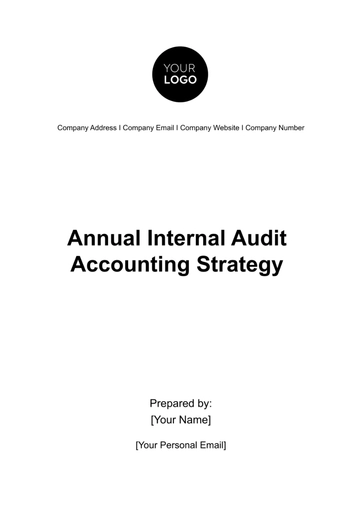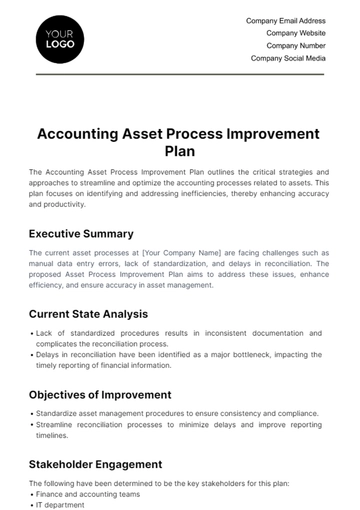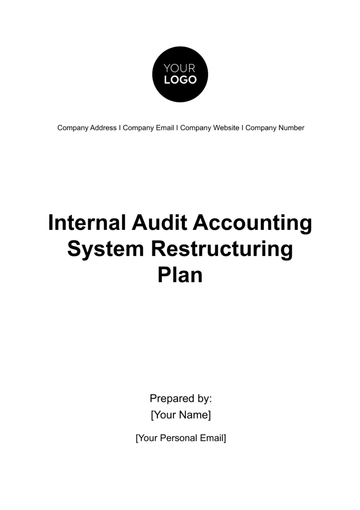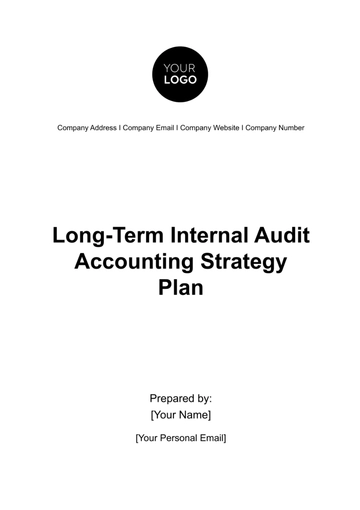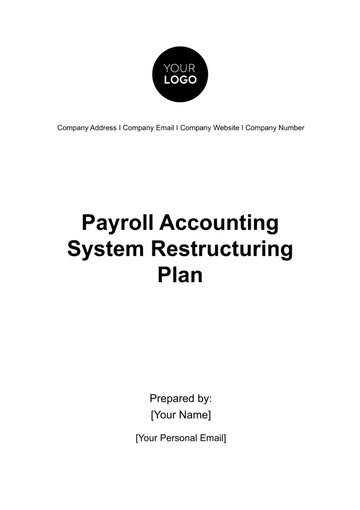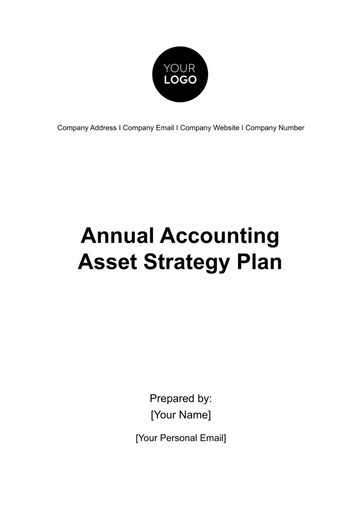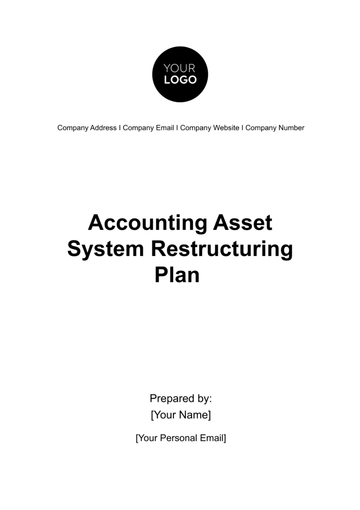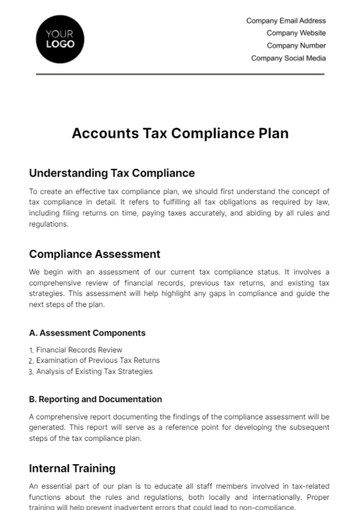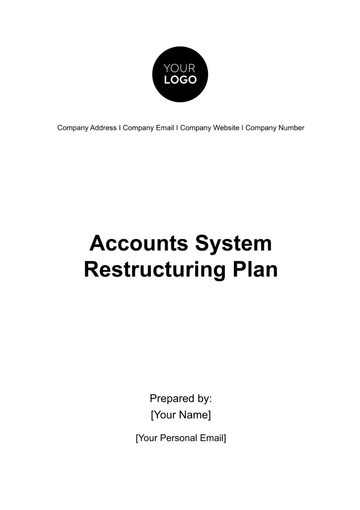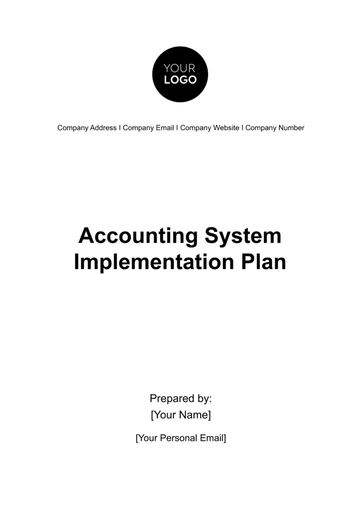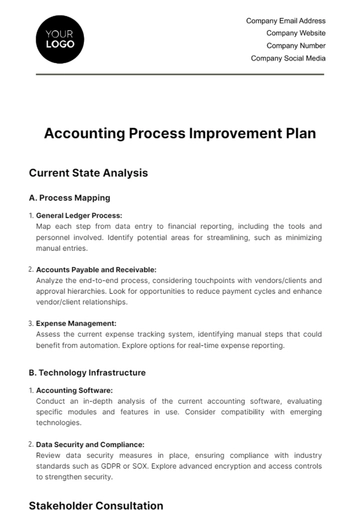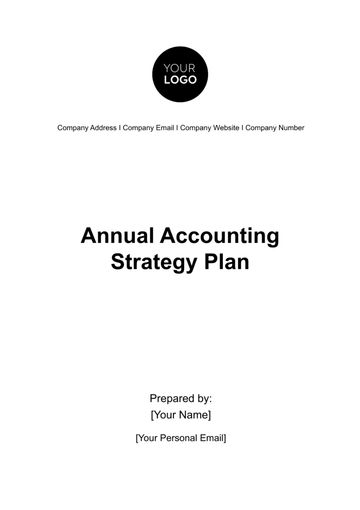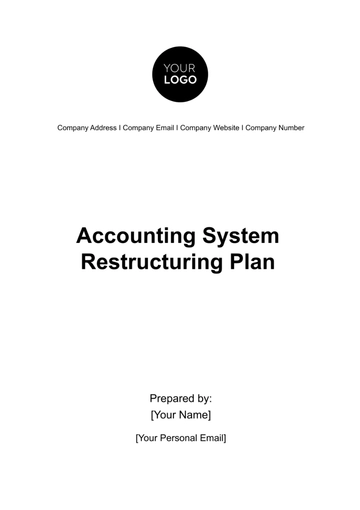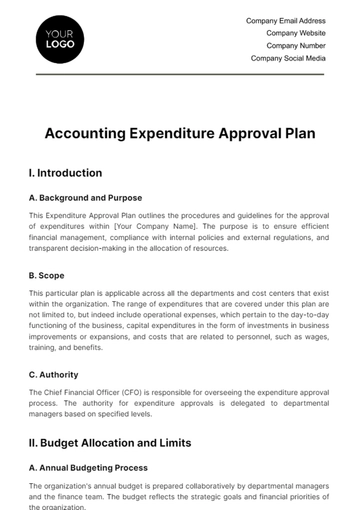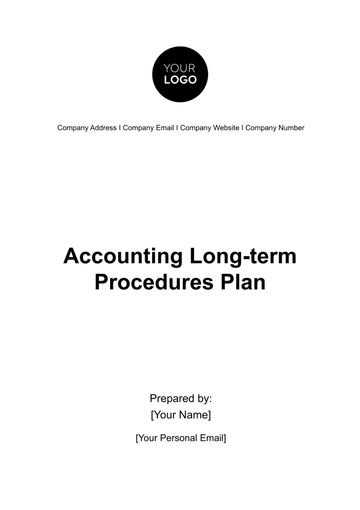Free Internal Audit Accounting System Restructuring Plan
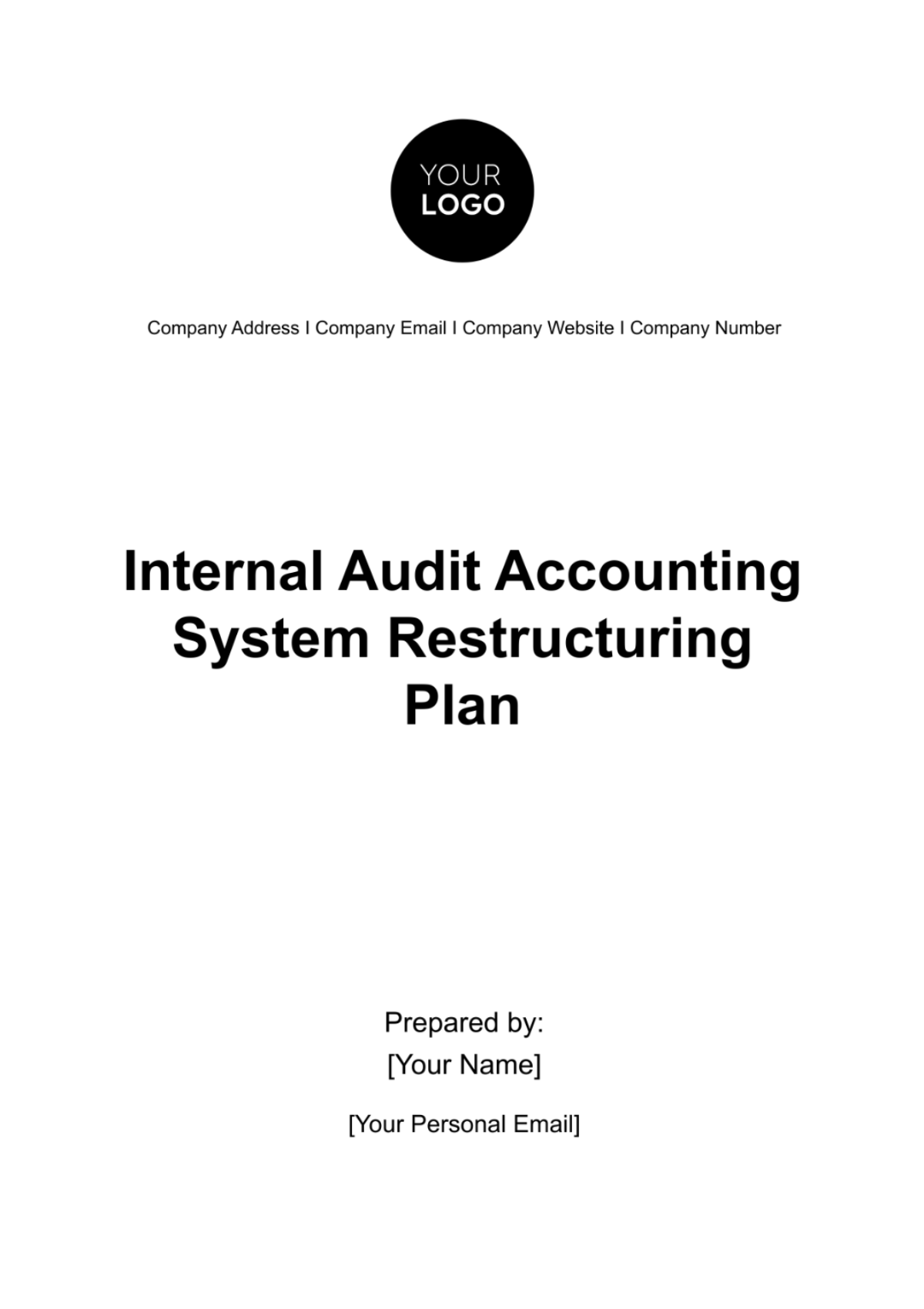
Executive Summary
This document serves as the Internal Audit Accounting System Restructuring Plan, developed in response to comprehensive internal audit findings. Our audit revealed significant opportunities to enhance the efficiency, accuracy, and compliance of our accounting systems and processes. The primary objective of this restructuring plan is to address these opportunities by implementing strategic changes to our current accounting infrastructure. Key initiatives include the adoption of new accounting software, the redesign of financial reporting processes, and the enhancement of internal controls to ensure compliance with the latest accounting standards. This plan outlines a detailed approach to executing these changes, including an implementation timeline, resource allocation, risk management strategies, and performance metrics for evaluation. Our ultimate goal is to ensure that our accounting systems and processes are robust, efficient, and capable of supporting our organization's strategic objectives and operational needs.
Background and Rationale
The need for restructuring our accounting system was identified during the latest internal audit, which highlighted several critical issues. Key findings included outdated accounting software that no longer meets our operational needs, inefficient manual processes prone to errors, and gaps in our internal controls that pose risks to compliance with regulatory standards. Furthermore, our current system's lack of integration capabilities has led to data silos, making timely and accurate financial reporting challenging and hindering informed decision-making.
The rationale for this restructuring is twofold: to enhance operational efficiency and to ensure compliance with evolving accounting standards and regulations. The audit findings indicated that our current systems and processes are not only inefficient but also put us at risk of non-compliance penalties and operational inefficiencies that could impact our financial performance.
Addressing these issues through a comprehensive restructuring of our accounting system will enable us to achieve a higher level of accuracy in our financial reporting, improve compliance with accounting standards, and enhance the overall efficiency of our financial operations. By investing in modern accounting software, streamlining processes, and strengthening internal controls, we can better support our organization's growth and adapt more readily to the dynamic business environment.
Objectives of the Restructuring Plan
The overarching goal of this restructuring plan is to overhaul our accounting systems and processes to achieve a state-of-the-art financial management framework. This framework will not only address current inefficiencies and compliance gaps but also position us for future growth and adaptability. The specific objectives of the restructuring plan include:
Enhance Compliance: To ensure full compliance with current and foreseeable accounting standards and regulations, thereby mitigating the risk of non-compliance penalties.
Improve Financial Reporting Accuracy: To significantly increase the accuracy of financial reporting, reducing the risk of misstatements and ensuring stakeholders have reliable financial information for decision-making.
Increase Operational Efficiency: To streamline accounting processes through automation and integration, reducing manual effort, minimizing errors, and speeding up financial reporting cycles.
Strengthen Internal Controls: To enhance internal controls over financial reporting, safeguarding assets, and ensuring the integrity of financial data.
Support Decision-Making: To provide timely, accurate, and comprehensive financial data to support strategic decision-making and performance monitoring.
Future-Proof the Accounting System: To adopt scalable and flexible accounting solutions that can adapt to changing business needs, regulatory requirements, and technological advancements.
Scope of the Restructuring
The scope of this restructuring plan is comprehensive, targeting several key areas within our accounting and financial management systems:
Accounting Software Upgrade: Selection and implementation of a new accounting software solution that offers enhanced functionality, integration capabilities, and compliance features.
Process Redesign: Redesign of critical accounting processes, including but not limited to, accounts payable and receivable, cash management, financial closing, and reporting procedures, to leverage automation and best practices.
Data Integration: Implementation of solutions for integrating disparate data sources to ensure a single source of truth for financial data, enhancing data accuracy and accessibility.
Internal Controls Overhaul: Review and enhancement of internal controls related to financial reporting, asset management, and fraud prevention.
Compliance Framework Update: Update the compliance framework to align with the latest accounting standards, regulatory requirements, and best practices, including training programs for staff on these updates.
Technology Infrastructure: Upgrade of the underlying technology infrastructure to support new accounting software, data analytics tools, and cybersecurity measures.
Current State Analysis
An in-depth analysis of our current accounting system and processes has identified several critical shortcomings, inefficiencies, and compliance issues that necessitate this restructuring. This analysis was conducted through a review of our internal audit findings, interviews with key personnel, and examination of our financial reporting cycles and internal control mechanisms.
Shortcomings and Inefficiencies
Area | Issue Identified | Impact (Estimated) |
Software | Outdated accounting software lacking integration capabilities | Increased manual data entry errors; delays in financial reporting |
Processes | Manual processing of accounts payable and receivable | High risk of human error; inefficient use of staff time |
Internal Controls | Inadequate controls over cash management | Potential for undetected fraud or misappropriation of assets |
Reporting | Delayed financial closing and reporting cycles | Late financial statements, affecting decision-making |
Compliance Issues
Compliance Area | Issue Identified | Potential Penalty (USD) |
Revenue Recognition | Failure to fully comply with ASC 606 standards | Up to $100,000 in fines and restatement costs |
Data Security | Inadequate controls to protect financial data | Up to $50,000 plus reputational damage |
Tax Reporting | Errors in tax computations due to manual processes | Interest and penalties on underpaid taxes estimated at $30,000 |
Analysis of the Current State
The current state analysis underscores significant areas for improvement within our accounting framework. The reliance on outdated software not only introduces operational inefficiencies but also hampers our ability to generate timely and accurate financial reports. This situation is exacerbated by manual processes that are prone to error, inefficient, and do not represent the best use of our staff's capabilities.
Moreover, the identified compliance issues pose a direct risk to our financial integrity and could result in substantial penalties and reputational damage. Particularly concerning is our compliance with revenue recognition standards (ASC 606), which is critical for accurate financial reporting and investor confidence. Similarly, our current practices around data security and tax reporting are not up to the mark, reflecting a need for a comprehensive overhaul of our accounting systems and processes.
The combination of operational inefficiencies and compliance risks highlighted by this analysis provides a compelling case for the proposed restructuring. Addressing these issues will not only bring us into compliance with accounting standards and regulatory requirements but also enhance the overall efficiency and accuracy of our financial operations, laying a solid foundation for future growth and stability.
Proposed Changes
To address the shortcomings, inefficiencies, and compliance issues identified in the current state analysis, we propose a series of strategic changes to our accounting system and processes. These changes are designed to modernize our accounting infrastructure, streamline operations, enhance compliance, and support strategic decision-making. Below are the detailed proposals for change:
Adoption of Integrated Accounting Software
To eliminate the reliance on outdated software and reduce manual data entry errors, we propose adopting a new, integrated accounting software solution. This software will offer advanced features such as automation of routine tasks, real-time financial reporting, and seamless integration with other business systems (e.g., ERP, CRM). The new system will facilitate faster financial closing and reporting cycles, improve data accuracy, and enhance overall operational efficiency.
Redesign of Accounting Processes
We aim to redesign our key accounting processes, including accounts payable and receivable, to leverage the capabilities of the new software fully. This will involve automating invoice processing, payments, and collections, thereby reducing the risk of human error and freeing up staff time for more strategic tasks. Process redesign will also include establishing new procedures for financial closing and reporting to ensure timeliness and accuracy.
Strengthening Internal Controls
To address the inadequacies in our internal controls, particularly in cash management, we plan to implement stronger control measures. This includes enhanced segregation of duties, regular reconciliations, and the use of automated alerts for unusual transactions. These measures will help prevent fraud, ensure the accuracy of our financial records, and safeguard company assets.
Enhancing Compliance Framework
To ensure full compliance with revenue recognition standards (ASC 606) and other regulatory requirements, we will update our compliance framework. This involves developing comprehensive policies and procedures, conducting regular compliance training for staff, and implementing controls specifically designed to monitor and enforce compliance with these standards.
Implementing Data Security Measures
Given the identified risks around data security, we propose implementing robust data protection measures. This includes the use of encryption, access controls, and regular security audits to protect sensitive financial information. These measures will help mitigate the risk of data breaches and ensure compliance with data protection regulations.
Improving Tax Reporting Processes
To address errors in tax computations and ensure accurate tax reporting, we propose adopting automated tax software that integrates with our new accounting system. This software will assist in accurately calculating taxes payable, ensuring timely filings, and reducing the risk of penalties associated with underpayment or late payment of taxes.
Implementing these proposed changes will require a coordinated effort across multiple departments and a commitment to change management principles to ensure a smooth transition. By undertaking these initiatives, we aim to build a more robust, efficient, and compliant accounting framework that can support our organization's strategic goals and operational needs.
Implementation Plan
To ensure the successful implementation of the proposed changes to our accounting system and processes, a detailed plan has been developed. This plan outlines the sequential steps required, assigns responsibilities, and sets a timeline for each phase of the implementation. Effective execution of this plan will be critical to achieving the desired improvements in efficiency, accuracy, and compliance.
Step | Month | Responsibility |
Approval of Restructuring Plan | Month 1 | Executive Team |
Selection of Integrated Accounting Software | Month 2-3 | IT Department & Finance Department |
Training on New Software | Month 4-5 | HR Department & External Vendors |
Process Redesign and Documentation | Month 6-7 | Finance Department & Process Managers |
Implementation of New Internal Controls | Month 8-9 | Internal Audit & Finance Department |
Compliance Framework Update | Month 10-11 | Compliance Department |
Data Security Enhancements | Month 12-13 | IT Security Team |
Rollout of Improved Tax Reporting Processes | Month 14-15 | Tax Department |
Review and Adjust Implementation | Month 16 | Internal Audit & Project Management Team |
Risk Management and Mitigation Strategies
Recognizing potential risks associated with the restructuring of our accounting system and processes is essential for proactive management and mitigation. The following table outlines identified risks, their likelihood, potential impact, and strategies for mitigation to ensure a smooth transition and realization of project objectives.
Risk | Likelihood | Impact | Mitigation Strategy |
Resistance to Change | High | Medium | Implement change management practices, including communication and training. |
Implementation Delays | Medium | High | Establish clear timelines and accountability; regular progress reviews. |
Data Migration Errors | Medium | High | Conduct thorough planning and testing; engage data migration experts. |
Software Integration Issues | Medium | Medium | Collaborate closely with IT and software vendors; phased testing approach. |
Overlooking Regulatory Requirements | Low | High | Regular reviews with the compliance department; external advisory services. |
Budget Overruns | Medium | Medium | Detailed budget planning; contingency funds; regular financial monitoring. |
Financial Impact
The financial implications of restructuring our accounting system and processes are significant, yet necessary for the long-term efficiency and compliance of our operations. A detailed budget has been prepared to outline the anticipated costs associated with software acquisition, training, process redesign, and other critical elements of the restructuring plan. This investment is anticipated to yield substantial benefits in terms of improved operational efficiency, reduced risk of non-compliance penalties, and enhanced accuracy in financial reporting.
Item | Estimated Cost (USD) |
Integrated Accounting Software | 100,000 |
Training on New Software | 30,000 |
Process Redesign and Documentation | 20,000 |
Implementation of New Controls | 15,000 |
Compliance Framework Update | 10,000 |
Data Security Enhancements | 25,000 |
Improved Tax Reporting Processes | 15,000 |
Contingency Fund | 20,000 |
Total Estimated Cost | 235,000 |
These budget considerations have been carefully compiled to ensure that all aspects of the restructuring plan are adequately funded, while also allocating a contingency fund to address any unforeseen expenses that may arise during implementation.
Performance Metrics and Evaluation
To measure the success of the restructuring plan and its impact on our accounting operations, a set of performance metrics has been established. These metrics will be monitored regularly to evaluate the effectiveness of the implemented changes and to identify areas for further improvement.
Metric | Target |
Reduction in Financial Reporting Cycle | 30% reduction within 12 months |
Increase in Reporting Accuracy | 95% accuracy in financial statements |
Compliance Incident Reduction | Zero compliance incidents post-implementation |
Employee Proficiency with New Software | 100% of accounting staff trained within 6 months |
Operational Efficiency Improvement | 20% reduction in manual processes |
Cost Savings from Process Improvements | $50,000 annual savings |
Training and Support
A comprehensive training and support program is crucial to the successful adoption of the new accounting system and the implementation of redesigned processes. Ensuring that all relevant staff are well-equipped with the necessary knowledge and skills will facilitate a smooth transition and maximize the effectiveness of the changes. Training will be tailored to different roles within the organization, focusing on the specific functionalities and processes relevant to each position.
Program Name | Target Audience | Description | Timeline |
New Accounting Software Orientation | Accounting & Finance Staff | Introduction to features and functionalities of the new software. | Month 4-5 |
Process Redesign Workshops | Process Owners & Managers | Detailed sessions on new processes and how to implement them effectively. | Month 6-7 |
Internal Controls Training | Internal Audit & Finance Staff | Training on new internal controls and compliance requirements. | Month 8-9 |
Data Security Awareness | All Employees | Educating staff on data protection best practices and security protocols. | Month 12-13 |
Tax Reporting and Compliance Update | Tax Department | Update on new tax reporting processes and compliance changes. | Month 14-15 |
Continuous Support Sessions | All Relevant Staff | Ongoing support sessions to address any questions or challenges. | Ongoing |
Communication Plan
Effective communication is key to ensuring that all stakeholders are informed, engaged, and supportive of the restructuring efforts. Our communication plan outlines a strategy for keeping all parties updated on the progress of the implementation, highlighting milestones achieved, and addressing any concerns that may arise. Communication will occur through multiple channels to ensure broad and effective reach.
Kickoff Meeting: To formally launch the restructuring project, outlining objectives, expectations, and roles.
Monthly Updates: Regular email newsletters and meetings to provide updates on the progress, achievements, and next steps.
Feedback Sessions: Scheduled sessions with key stakeholders to gather feedback, address concerns, and adjust plans as necessary.
Training Announcements: Timely notifications about training schedules, objectives, and expectations.
Success Stories: Sharing early wins and success stories to build momentum and reinforce the benefits of the restructuring.
- 100% Customizable, free editor
- Access 1 Million+ Templates, photo’s & graphics
- Download or share as a template
- Click and replace photos, graphics, text, backgrounds
- Resize, crop, AI write & more
- Access advanced editor
Revolutionize your audit system with the Internal Audit Accounting System Restructuring Plan Template from Template.net. This editable and customizable template is engineered to guide you through comprehensive restructuring of your accounting audit systems. Editable in our AI Editor tool, it allows for meticulous customization to address the unique challenges and objectives of your organization.
You may also like
- Finance Plan
- Construction Plan
- Sales Plan
- Development Plan
- Career Plan
- Budget Plan
- HR Plan
- Education Plan
- Transition Plan
- Work Plan
- Training Plan
- Communication Plan
- Operation Plan
- Health And Safety Plan
- Strategy Plan
- Professional Development Plan
- Advertising Plan
- Risk Management Plan
- Restaurant Plan
- School Plan
- Nursing Home Patient Care Plan
- Nursing Care Plan
- Plan Event
- Startup Plan
- Social Media Plan
- Staffing Plan
- Annual Plan
- Content Plan
- Payment Plan
- Implementation Plan
- Hotel Plan
- Workout Plan
- Accounting Plan
- Campaign Plan
- Essay Plan
- 30 60 90 Day Plan
- Research Plan
- Recruitment Plan
- 90 Day Plan
- Quarterly Plan
- Emergency Plan
- 5 Year Plan
- Gym Plan
- Personal Plan
- IT and Software Plan
- Treatment Plan
- Real Estate Plan
- Law Firm Plan
- Healthcare Plan
- Improvement Plan
- Media Plan
- 5 Year Business Plan
- Learning Plan
- Marketing Campaign Plan
- Travel Agency Plan
- Cleaning Services Plan
- Interior Design Plan
- Performance Plan
- PR Plan
- Birth Plan
- Life Plan
- SEO Plan
- Disaster Recovery Plan
- Continuity Plan
- Launch Plan
- Legal Plan
- Behavior Plan
- Performance Improvement Plan
- Salon Plan
- Security Plan
- Security Management Plan
- Employee Development Plan
- Quality Plan
- Service Improvement Plan
- Growth Plan
- Incident Response Plan
- Basketball Plan
- Emergency Action Plan
- Product Launch Plan
- Spa Plan
- Employee Training Plan
- Data Analysis Plan
- Employee Action Plan
- Territory Plan
- Audit Plan
- Classroom Plan
- Activity Plan
- Parenting Plan
- Care Plan
- Project Execution Plan
- Exercise Plan
- Internship Plan
- Software Development Plan
- Continuous Improvement Plan
- Leave Plan
- 90 Day Sales Plan
- Advertising Agency Plan
- Employee Transition Plan
- Smart Action Plan
- Workplace Safety Plan
- Behavior Change Plan
- Contingency Plan
- Continuity of Operations Plan
- Health Plan
- Quality Control Plan
- Self Plan
- Sports Development Plan
- Change Management Plan
- Ecommerce Plan
- Personal Financial Plan
- Process Improvement Plan
- 30-60-90 Day Sales Plan
- Crisis Management Plan
- Engagement Plan
- Execution Plan
- Pandemic Plan
- Quality Assurance Plan
- Service Continuity Plan
- Agile Project Plan
- Fundraising Plan
- Job Transition Plan
- Asset Maintenance Plan
- Maintenance Plan
- Software Test Plan
- Staff Training and Development Plan
- 3 Year Plan
- Brand Activation Plan
- Release Plan
- Resource Plan
- Risk Mitigation Plan
- Teacher Plan
- 30 60 90 Day Plan for New Manager
- Food Safety Plan
- Food Truck Plan
- Hiring Plan
- Quality Management Plan
- Wellness Plan
- Behavior Intervention Plan
- Bonus Plan
- Investment Plan
- Maternity Leave Plan
- Pandemic Response Plan
- Succession Planning
- Coaching Plan
- Configuration Management Plan
- Remote Work Plan
- Self Care Plan
- Teaching Plan
- 100-Day Plan
- HACCP Plan
- Student Plan
- Sustainability Plan
- 30 60 90 Day Plan for Interview
- Access Plan
- Site Specific Safety Plan


